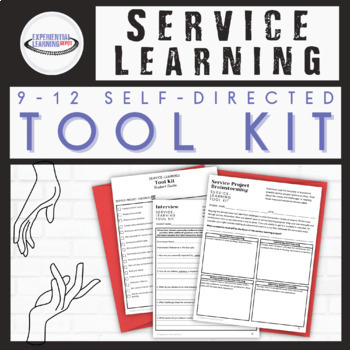Self-Directed Service-Learning Project Tool Kit for High School Students
- PDF
- Easel Activity
Also included in
- Self-directed learning in the classroom or homeschool is a great way to gain content knowledge and build 21st-century skills simultaneously. This bundle includes five student-directed learning tool kits: Scientific open inquiryProject-based learningProblem-based learningMaker projectsService-learninPrice $28.00Original Price $35.00Save $7.00
- Teaching 21st-century skills doesn't have to be an extra task. What if your students could learn content and develop 21st century skills at the same time without you having to overthink it or over plan? This resource is a bundle of 21st century skills learning activity tool kits that organically incPrice $40.00Original Price $50.00Save $10.00
- Are you looking for open-ended homeschool or classroom experiential learning activity resources for any and all subjects or targets? Or maybe you're interested in adding experiential learning activity experiences to your classroom or homeschool curriculum but aren't sure how to facilitate it, don'tPrice $40.00Original Price $50.00Save $10.00
- Are you looking for real-world, authentic service-learning projects for your high school students without sacrificing more of your time directing the experience or pulling materials together? This mini-bundle offers ready-made materials for student-led service-learning projects that revolve around lPrice $11.25Original Price $12.50Save $1.25
Description
Service-learning projects for self-directed learners offer a great opportunity for high school students to give back to their communities, develop 21st-century skills, and build their resumes through community involvement.
Individuals or small groups design and lead their own service-learning projects while you facilitate. This tool kit provides guiding templates to scaffold students seamlessly and independently through the experience from start to finish.
"I used it to lay the groundwork for service-learning projects. Gave me a great place to start." - Heather
Using the tool kit, individuals or small groups will:
- Choose a community topic
- Research that topic in-depth
- Interview community members to identify specific needs related to the subtopic
- Brainstorm service-learning projects with the intention of filling the defined need
- Complete service-learning projects.
There is very little prep on your part. Simply introduce the experience, print the guiding templates, and facilitate and manage experiences.
Check out the free service-learning implementation spreadsheet included with my free experiential learning tools mini-bundle by clicking here.
***This resource includes a printable PDF, a digital Google Slides, and a digital TPT Easel option. This resource is not editable at this time.
Timeframe: I did not add a specific time duration for this project because it will vary widely based on learning structure and project details. A service-learning project could take anywhere from 2 weeks to 9 months. If you tell students that they have 2 weeks to complete these projects, they will plan their experiences around that timeline.
Service-Learning Project Tool Kit Includes:
- A teacher guide with service-learning project facilitation steps
- Student service-learning project description, overall project instructions, and service-learning examples to help guide and inspire
- Service-learning project checklist
- Interest survey to identify a community topic of interest and a perceived community interest
- Research guide with guiding questions and room to add student research questions
- Interview template with some guiding questions to get students started and room for notes
- Service-learning project brainstorming mind map
- Service-learning project planning templates
- Project-specific service-learning experience task list
- Presentation planner
- Service-learning project plan summary
- Service-learning project reflection
- Service-learning rubric
If you liked this resource, check out these products as well!
- Problem-Based Curriculum Tool Kits Bundle: Community Action Projects & Problem-Based Learning
- Self-Directed Project-Based Learning: Current Events
Helpful and Relevant Blog Post from ELD
Interested in new resource alerts, freebies, tips, tricks, and more?
- Click the green star to get new resource alerts
- Join my newsletter.
- Blog – Experiential Learning Depot
- Facebook.
- Facebook Group - Experiential Learning Community for k-12 Teachers
Earn TPT Credits:
Follow Experiential Learning Depot and earn TpT credits by giving feedback on this product. A sincere thank you for your business. Feel free to contact me through email at any time with questions on this product - experientiallearningdepot@gmail.com
Cover Font Credit: MR. FISK Fonts










